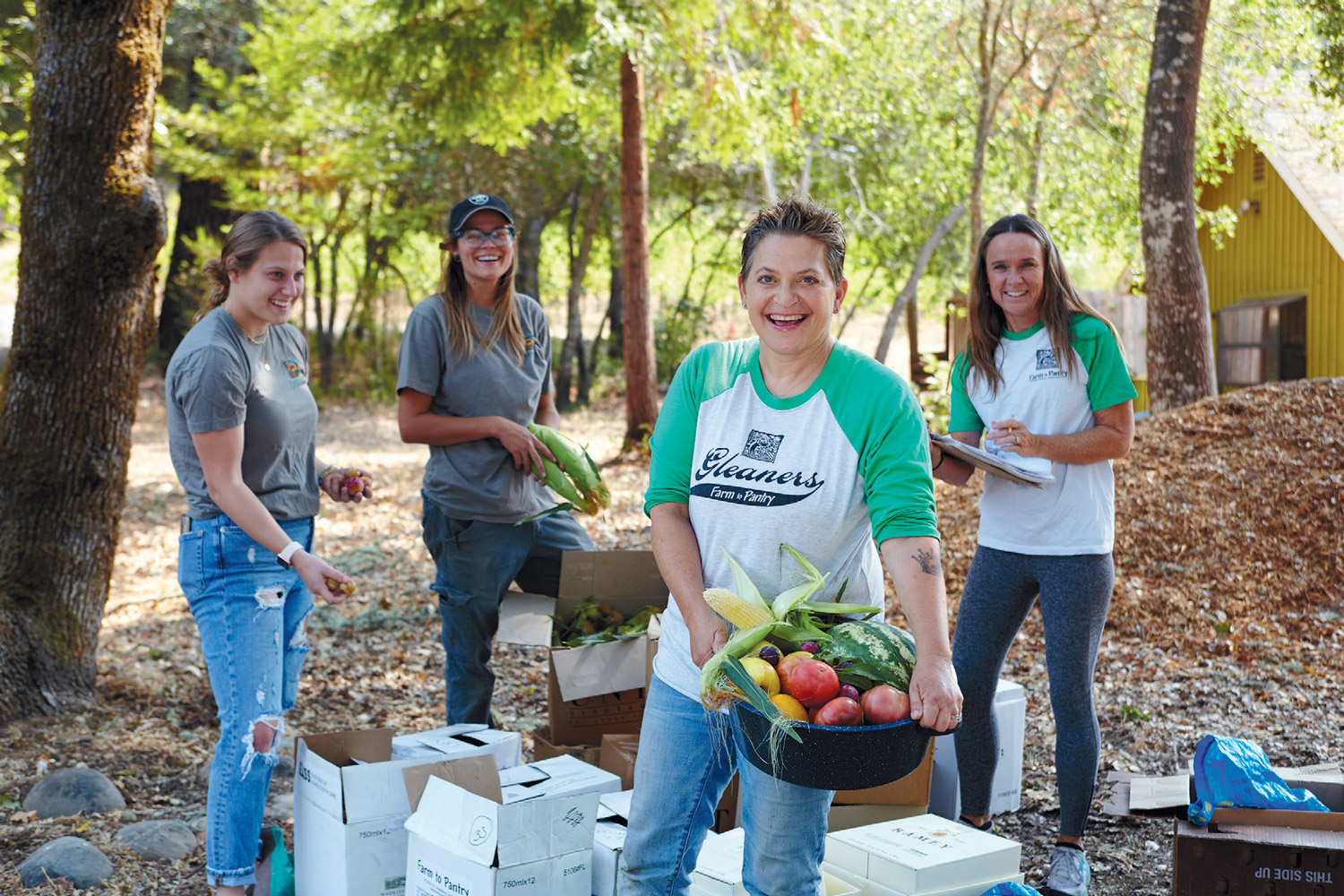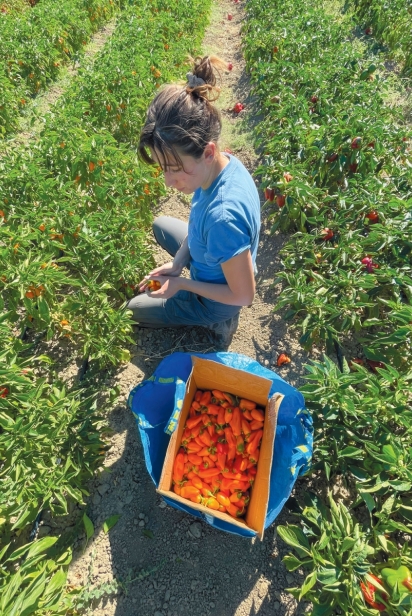Farm to Pantry
Ensuring Nothing Goes To Waste
A few miles east of Healdsburg, in an idyllic valley carved by the Russian River, Front Porch Farm’s fields are popping with spots of color—bright yellow, orange and red peppers, gleaming in the October sun. This abundance of healthy crops belies the harsh reality of another year of drought in this region; in early August, river water that is normally diverted to hundreds of growers and ranchers in the Russian River watershed was shut off. Front Porch Farm’s operations, and sales, wound down to a trickle and the surviving crops—including the colorful peppers and tomatoes that managed to hold on until this warm fall morning—have been dry-farmed.
Enter Duskie Estes, celebrity chef, restaurateur and North Bay community activist who, in the spring of 2020, became executive director of Farm to Pantry, a Healdsburg-based nonprofit that addresses hunger by rescuing food that would otherwise go to waste.
On this October day, Front Porch Farm has welcomed Estes and three volunteer gleaners who accompany her to harvest rows of these clearly hardy peppers. Gleaning is an ancient term to describe the practice of gathering left over grain or produce after a main harvest. Estes and this morning’s glean team are not technically gathering “left overs,” however; because of the water shortage, Front Porch curtailed their sales for the year. But the essence of the gleaners’ work is the same: They gather excess to feed those who need it most.
Estes, Susan Backer, Joyce Thompson and Elle Harlow watch as Sarah Dublin, Front Porch Farm’s farm manager, picks a sweet pepper and turns it over to reveal an underside scarred by sunburn. She encourages the gleaners to look carefully at each side of the pepper as they pick, to avoid tossing damaged peppers into the boxes. “Yes, we want the beautiful produce,” Estes adds.
And Estes knows beautiful produce. As a Food Network “Iron Chef “ competitor and owner/chef at several award-winning restaurants and enterprises, including the now closed Zazu in Sebastopol and Black Pig Meat Co., both of which she opened with her husband, John Stewart, she has spent decades transforming the bounty of our region’s most unique and productive organic farms into delectable dishes. As a James Beard Foundation Award recipient in 2001, Estes trained to address the media and the public about social justice issues, and her commitment to food justice has paralleled her culinary career. Her resume includes time in the kitchen at Glide Memorial Church in San Francisco and working for the White House as part of the Share Our Strength program, where she organized service opportunities for chefs to feed the hungry.
Now, as executive director of Farm to Pantry, Estes perfectly pairs her passion for produce with her commitment to the underserved people of her community. Farm to Pantry relies upon volunteers to harvest and deliver the bounty of fresh vegetables, fruit, eggs, cheese, even flower bouquets, in food boxes to low-income housing units, community nonprofits and food pantries. Since it was founded by food justice activist Melita Love in 2008, the organization has delivered almost 4 million servings of fruits and vegetables to those in need. In 2020 alone, the organization rescued over 200,000 pounds of produce.
“To be in the midst of so much bounty, and then, at the same time, to have so many people hungry here in Sonoma …” says Estes, her sentence drifting off as she struggles with the disparity. “One in three people in our communities face food insecurity. These are the agricultural workers who grow and harvest our food in this county, and they cannot afford the food they help grow.”
The notion of leaving a portion of commercial crops unharvested has been accepted as a form of social welfare for thousands of years, and is mentioned in both the Koran and the Old Testament of the Bible, which commands Hebrew farmers to leave crops for the poor. In certain European countries, the right to pick leftover crops was codified until the 19th century, and here in the U.S. the practice was an accepted part of rural communities until the mid-20th century, when private property laws and large-scale agriculture diminished gleaning access.
But as the particularly troubling duality of wasted food and hungry citizens becomes more acute in our nation, organizations like Farm to Pantry have mobilized around gleaning. According to a 2018 Environmental Protection Agency report, 63 million tons of food was wasted in 2018, compared to 12.2 million in 1960, and between 2010 and 2017 there was an 8% increase in food waste per capita. At the same time, the USDA reports, 38 million people in the United States were food insecure in 2020.
Set in the larger context of a decades-long increase in the disparity between the rich and poor in our nation, Sonoma County has faced a series of exacerbating disasters. Starting in October 2017 when the Wine Country fires blazed for weeks, the ensuing years have brought summer wildfires, the Covid-19 pandemic and drought. The circumstances have been particularly dire for those whose livelihoods depend on seasonal agricultural work.
Vineyard workers are financially dependent upon two seasons, pruning and harvest, but many vineyards in the region, even those that did not burn, have not harvested due to smoke taint, leaving a large number of vineyard workers without income. Additionally, restaurant closures during the pandemic have affected employment across the food system, and whether loss of work is due to natural disaster, pandemic, drought or other circumstances, those who are undocumented are critically insecure as they do not receive unemployment checks. Farm to Pantry has grown rapidly to meet the fast-growing need in these unsettled times.
“One thing the pandemic did is shine a light on how fragile our food system is,” says Estes. “The farms in our region rely on their direct connection to restaurants, and that disappeared overnight—there was no one to buy their food.”
Producers began calling Farm to Pantry, which recruits the volunteer power to harvest, so their crops would not simply go to waste. “In fact, we’ve been able to recruit more volunteers to rescue the unused crops during the pandemic,” says Estes. “In part because people have been looking for ways to volunteer and have felt more comfortable working in an outdoor setting.”
At the height of the fall harvest, Farm to Pantry teams glean six days a week, up to three gleans in different locations a day. The organization’s volunteer workforce has grown from approximately 45 volunteers at 40 properties in 2019 to over 300 volunteers at more than 300 properties in 2021. Gleaning happens on farms and on private property from as far south as Petaluma, and north to Lake County. Community partnerships for distribution have also grown over the past years, climbing from 30 partners in 2019 to 150 last year. Additionally, Estes and her team have raised funds to purchase 62 CSA food boxes from FEED Sonoma cooperative (see story on FEED Sonoma in this edition).
“Our goal is to get this food into people’s bellies and keep it out of landfill,” says Estes. She explains that there is also a critical environmental angle to Farm to Pantry’s work: Food waste is increasingly acknowledged as a significant contributor to global warming. According to recent data from a joint report by the World Wildlife Fund and TESCO, 10% of greenhouse gas emissions in the U.S. comes from food waste, and up to 40% of food in the U.S. ends up in landfill, so diverting food waste is a critical pathway to reduce methane pollution.
A group of seasoned gleaners, the team at Front Porch is now filling their second boxes with peppers. Backer and Thompson are retired North Bay residents who volunteer regularly. They both describe a discomfort many of us feel but do not know how to address: We recognize the poverty and food insecurity that exists around in the North Bay, right here amidst us in our world-famous and wildly bountiful region.
“It has always pained me to see such abundance, and at the same time to see food go to waste,” says Thompson. “How do we get this food to those in need? This is how.” Backer adds that volunteering with Farm to Pantry on unique properties brings her joy, exposing her to the diversity of farms and crops in her own backyard.
Harlow, who is a few weeks into her AmeriCorps year working at Farm to Pantry, describes the satisfaction of dropping food boxes off at housing units or community centers, including, among others, Corazon, Ortiz Plaza, La Familia Sona, Ceres Community Project and Burbank Housing sites. “Last week I was dropping off food boxes in Healdsburg and even before I finished unloading, people were looking through the boxes, telling me how beautiful the produce looked, and thanking me.”
Jacob Rich is the residential services coordinator for Burbank affordable housing sites across Sonoma County who distributes boxes delivered by Farm to Pantry. “The residents here are on fixed incomes and they would not otherwise be able to afford the produce that arrives in Farm to Pantry boxes,” says Rich. “I get feedback about the boxes—it might be about an heirloom tomato or an heirloom eggplant. People are blown away by the quality of the food they receive.”
In Cloverdale, Zeke Guzman, Latinx community leader and founder of La Familia Sana, a nonprofit providing food, health and housing support for the underserved in his community, distributes up to 42 Farm to Pantry boxes to local families, many of them farmworkers. “Here is something I would like to point out, something important about Farm to Pantry boxes,” says Guzman: “They do not just give food—they give good food, nutritious food. This is culturally appropriate food that people will cook with. People who get these boxes will eat all of it.”
While many food banks collect and distribute canned or boxed food, the daily distribution schedule of Farm to Pantry—glean in the morning, distribute in the afternoon—allows for the delivery of fresh food. “In the Latinx community, almost 50% of people have diabetes or prediabetes,” Guzman continues. “This is because of what they eat. Now you see why I appreciate Duskie and Farm to Pantry and why I wish they had the resources to do even more.”
At Front Porch Farm, the boxes full of sweet peppers have filled up a tarp set out by the Farm to Pantry delivery truck. “We are a village here in the North Bay, with neighbors helping neighbors. Everyone has something they can give,” says Estes, standing up to add her overflowing box of peppers to the tarp. “Dignity is a very important piece here,” she says. “Studies show that being a food recipient as a child can have a deep psychological effect. It can bring a feeling of shame that you carry for the rest of your life.”
Estes aims to honor the people who support the agricultural system with the food she and her team glean, so each box must be made with care, similar to a high-end CSA box, filled with the most nutritious food available—and, as often as is possible, include a bouquet of flowers. “This is the exact same food that Michelin-starred restaurants get. That is the food justice piece—this is not just for the lucky. Everyone deserves access to this type of food.”
For more information and to volunteer to glean with Farm to Pantry, visit FarmToPantry.org.







